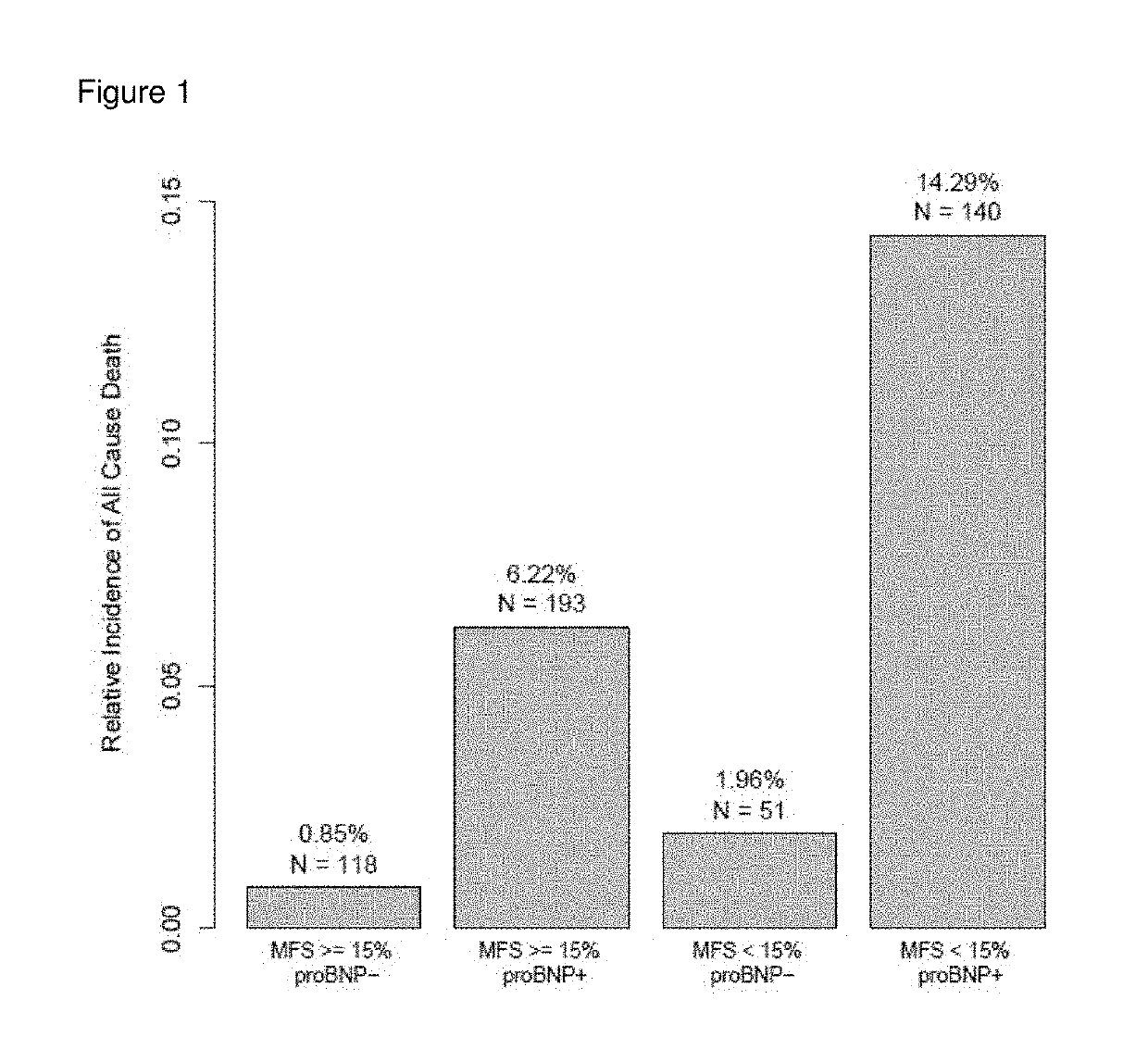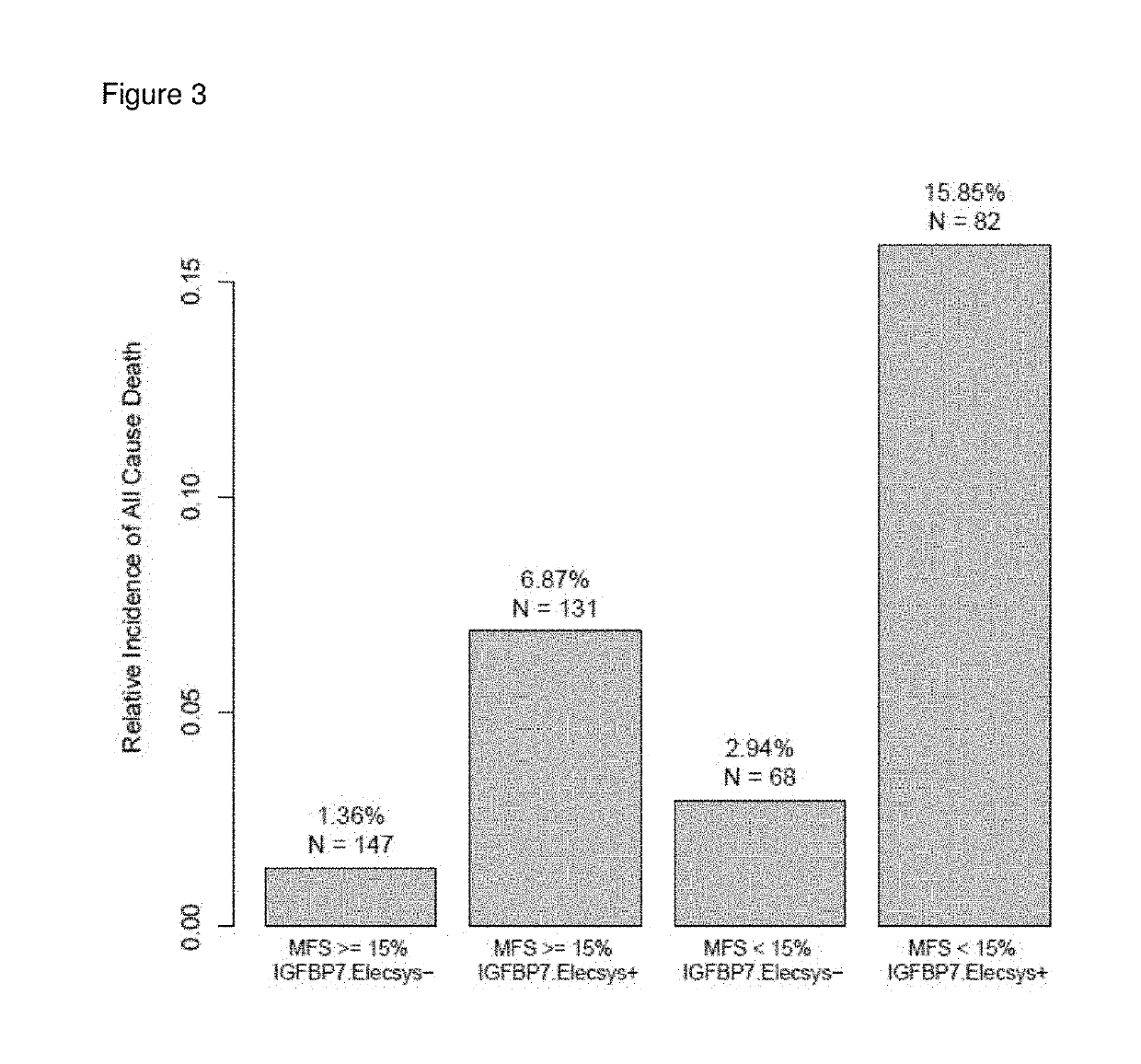Biomarkers for risk prediction of mortality
a biomarker and risk prediction technology, applied in the field of biomarkers for risk prediction of mortality, can solve the problems of major and growing public health problems such as heart failur
- Summary
- Abstract
- Description
- Claims
- Application Information
AI Technical Summary
Benefits of technology
Problems solved by technology
Method used
Image
Examples
example 1
[0137]The combination of several circulating biomarkers with abnormal midwall fractional shortening (MFS), an early echocardiographic indicator of preclinical systolic dysfunction, with adverse outcome was investigated.
[0138]Circulating levels of various biomarkers (NTproBNP, ICAM1, cTNT, FGF23, IGFBP7, MMP2, PLGF, eSelectin, GDF15, ST2, Galectin-3, Vitamin D, CRP, CystatineC, OPN, P1NP, Mimecan, Endostatin, proANP, ANG2) were measured in 550 elderly individuals (age 65-84 years) selected from the in PREDICTOR study. Participants were referred to cardiology centers for clinical examination and comprehensive Doppler echocardiography with centrally-measured MFS. Absolute numbers of all cause death were available after a median follow-up of 46 [39-54] months from record-linkage of administrative data. Death was recorded in 36 cases.
[0139]Individuals with LV midwall dysfunction (MFS75th age- and sex-specific percentile) was 14.29% vs. 1.96% (abnormal MFS, low NT-proBNP), 6.22% (normal M...
example 2
[0149]The combination of the biomarkers referred to in Example 1 with abnormal MFS was investigated further in a subset of samples derived from participants of the PREDICTOR study with normal left ventricular mass.
[0150]Individuals with LV midwall dysfunction (MFS75th age- and sex-specific percentile) was 13.51% vs. 0% (abnormal MFS, low NT-proBNP), 6.77% (normal MFS, high NT-proBNP) and 1.06% (normal MFS, low NT-proBNP) (FIG. 6). Corresponding values for IGFBP7 above median concentration were 16, 0%, 6.93% and 1.9% (FIG. 8).
[0151]Absolute numbers of death among individuals with abnormal MFS and elevated cTnT (>3 ng / L) were 5 vs. 0 (abnormal MFS, low cTnT), 8 (normal MFS, high cTnT) and 2 (normal MFS, low cTnT)(FIG. 7). Corresponding numbers for sST2 above median concentration were 3.2, 9 and 1. Corresponding numbers for FGF23 above median concentration were 5, 0, 7 and 3. (FIG. 9) (FIG. 10).
[0152]Elevation in of circulating NTproBNP, cTnT, IGFBP7, FGF23 or sST2 combined with early ...
example 3
[0154]The combination of several circulating biomarkers with left ventricular hypertrophy, an early echocardiographic indicator of preclinical structural heart disease, with adverse outcome was investigated.
[0155]Circulating levels of NT-proBNP, ICAM-1, ST2, hsCRP, CystatinC, proANP, VitaminD, FGF23, GDF15 and IGFBP7 were measured in 550 elderly individuals (age 65-84 years) selected from the in PREDICTOR study. Absolute numbers of death were available after a median follow-up of 46 [39-54] months from record-linkage of administrative data. death was recorded in 36 cases.
[0156]Individuals with LVH had higher levels of NT-proBNP and IGFBP7, or than those with normal function. The relative incidence of mortality among individuals with LVH, elevated NTproBNP (>75th age and sex specific percentiles) and elevated IGFBP7 (above median concentration) was 19.15% vs. 0% (LVH, low NTproBNP, low IGFBP7), 13.79% (no LVH, high NTproBNP, high IGFBP7) and 1.08% (no LVH, low NTproBNP, low IGFBP7) (...
PUM
| Property | Measurement | Unit |
|---|---|---|
| soluble | aaaaa | aaaaa |
| imaging | aaaaa | aaaaa |
| mass | aaaaa | aaaaa |
Abstract
Description
Claims
Application Information
 Login to View More
Login to View More - R&D
- Intellectual Property
- Life Sciences
- Materials
- Tech Scout
- Unparalleled Data Quality
- Higher Quality Content
- 60% Fewer Hallucinations
Browse by: Latest US Patents, China's latest patents, Technical Efficacy Thesaurus, Application Domain, Technology Topic, Popular Technical Reports.
© 2025 PatSnap. All rights reserved.Legal|Privacy policy|Modern Slavery Act Transparency Statement|Sitemap|About US| Contact US: help@patsnap.com



